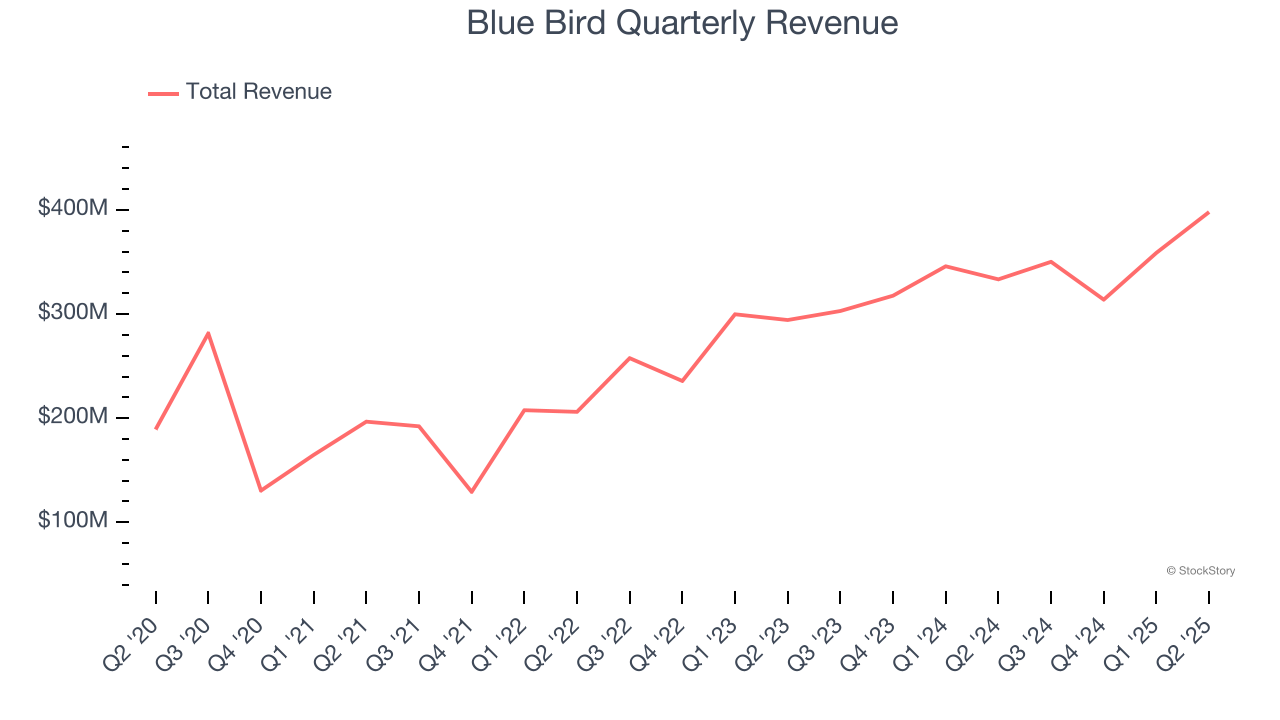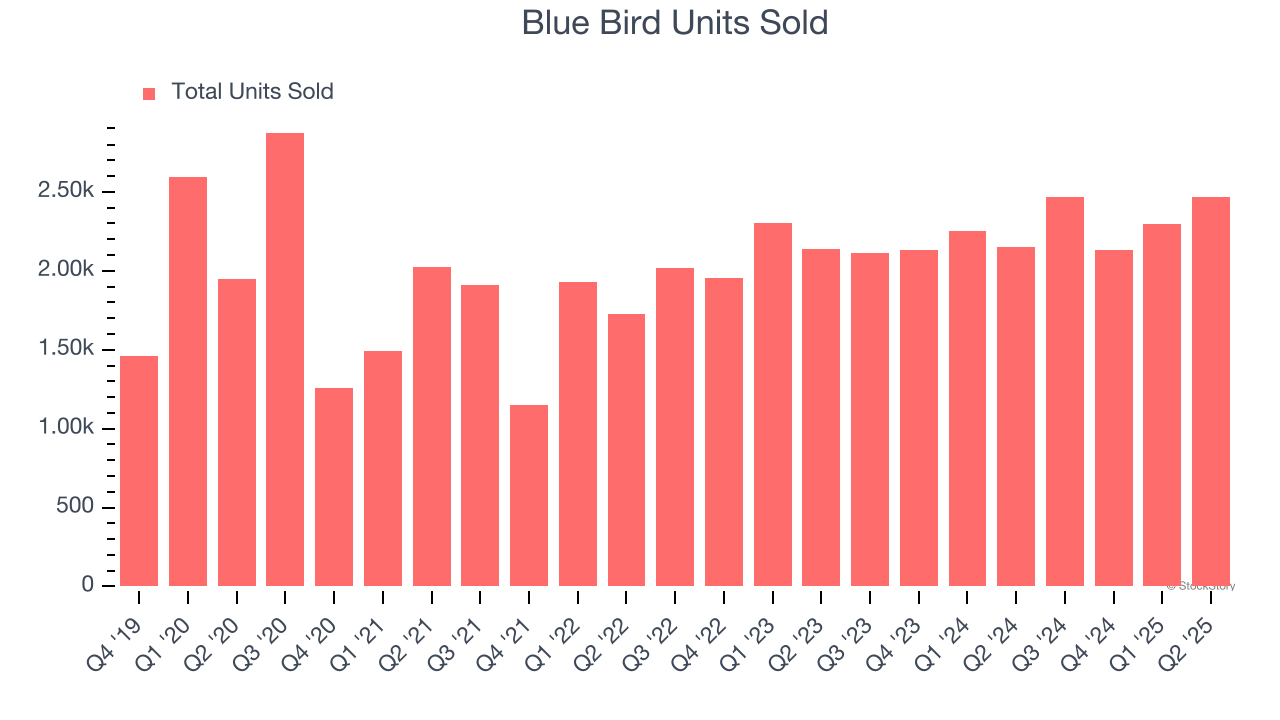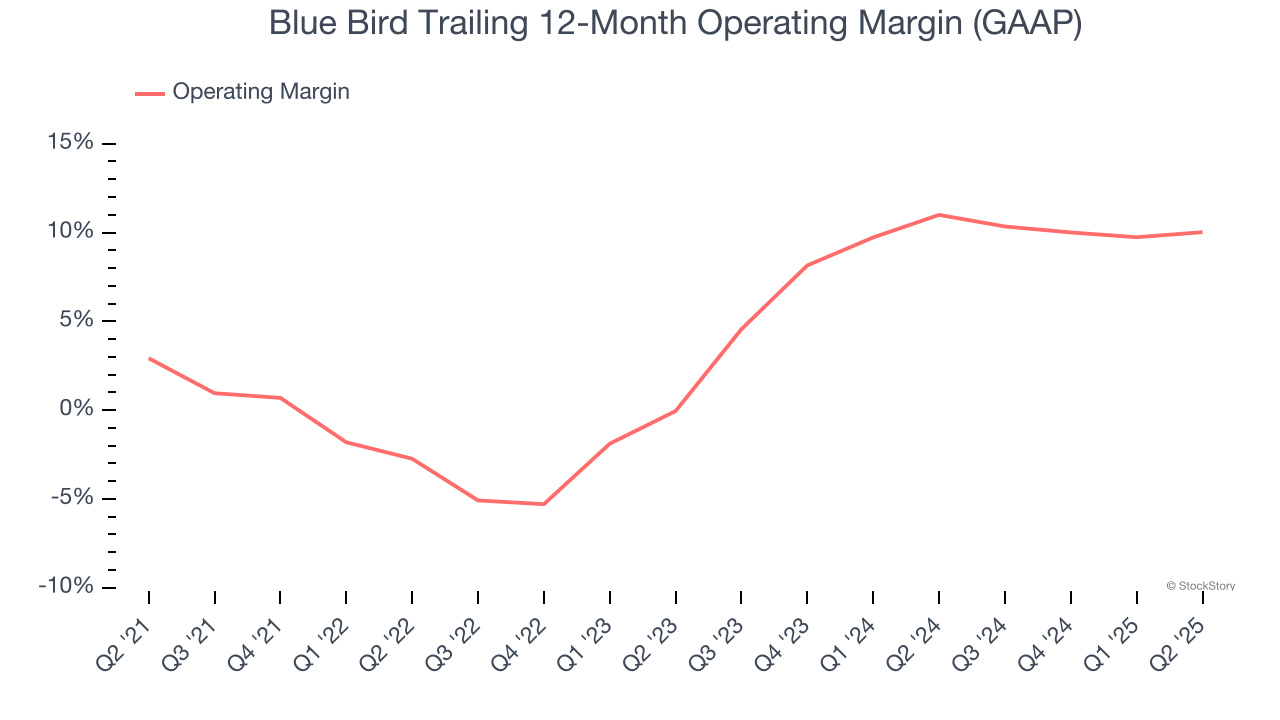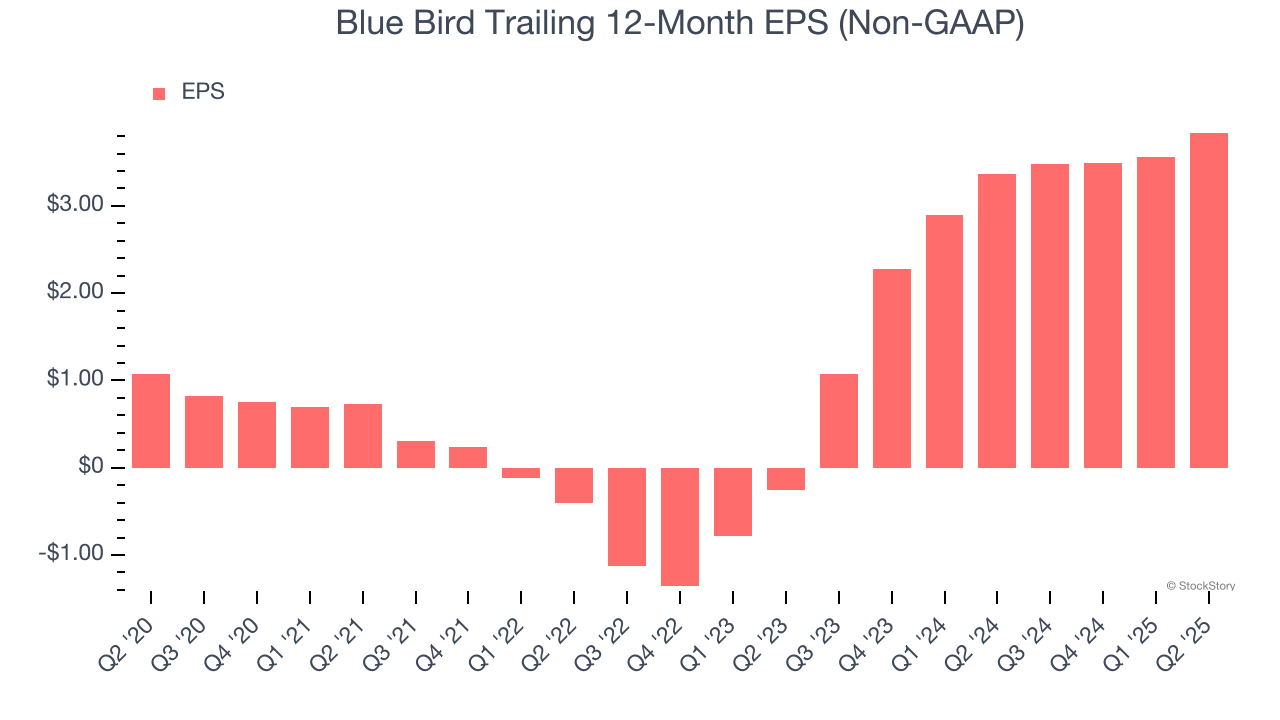
School bus company Blue Bird (NASDAQ: BLBD) reported Q2 CY2025 results topping the market’s revenue expectations, with sales up 19.4% year on year to $398 million. The company expects the full year’s revenue to be around $1.45 billion, close to analysts’ estimates. Its non-GAAP profit of $1.19 per share was 20.9% above analysts’ consensus estimates.
Is now the time to buy Blue Bird? Find out by accessing our full research report, it’s free.
Blue Bird (BLBD) Q2 CY2025 Highlights:
- Revenue: $398 million vs analyst estimates of $377.4 million (19.4% year-on-year growth, 5.5% beat)
- Adjusted EPS: $1.19 vs analyst estimates of $0.98 (20.9% beat)
- Adjusted EBITDA: $58.48 million vs analyst estimates of $51.05 million (14.7% margin, 14.5% beat)
- The company reconfirmed its revenue guidance for the full year of $1.45 billion at the midpoint
- EBITDA guidance for the full year is $210 million at the midpoint, above analyst estimates of $198 million
- Operating Margin: 12.6%, in line with the same quarter last year
- Free Cash Flow was $52.32 million, up from -$3.51 million in the same quarter last year
- Sales Volumes rose 14.7% year on year (0.7% in the same quarter last year)
- Market Capitalization: $1.38 billion
“I am incredibly proud of our team in delivering another outstanding result, achieving a new all-time quarterly record revenue and profit,” said John Wyskiel, President & CEO of Blue Bird Corporation.
Company Overview
With around a century of experience, Blue Bird (NASDAQ: BLBD) is a manufacturer of school buses and complementary parts.
Revenue Growth
A company’s long-term sales performance can indicate its overall quality. Any business can experience short-term success, but top-performing ones enjoy sustained growth for years. Luckily, Blue Bird’s sales grew at a decent 8.6% compounded annual growth rate over the last five years. Its growth was slightly above the average industrials company and shows its offerings resonate with customers.

We at StockStory place the most emphasis on long-term growth, but within industrials, a half-decade historical view may miss cycles, industry trends, or a company capitalizing on catalysts such as a new contract win or a successful product line. Blue Bird’s annualized revenue growth of 14.3% over the last two years is above its five-year trend, suggesting its demand recently accelerated. Blue Bird’s recent performance shows it’s one of the better Heavy Transportation Equipment businesses as many of its peers faced declining sales because of cyclical headwinds. 
We can dig further into the company’s revenue dynamics by analyzing its number of units sold, which reached 2,467 in the latest quarter. Over the last two years, Blue Bird’s units sold averaged 5.7% year-on-year growth. Because this number is lower than its revenue growth, we can see the company benefited from price increases. 
This quarter, Blue Bird reported year-on-year revenue growth of 19.4%, and its $398 million of revenue exceeded Wall Street’s estimates by 5.5%.
Looking ahead, sell-side analysts expect revenue to grow 8.4% over the next 12 months, a deceleration versus the last two years. Despite the slowdown, this projection is above average for the sector and implies the market is baking in some success for its newer products and services.
Today’s young investors won’t have read the timeless lessons in Gorilla Game: Picking Winners In High Technology because it was written more than 20 years ago when Microsoft and Apple were first establishing their supremacy. But if we apply the same principles, then enterprise software stocks leveraging their own generative AI capabilities may well be the Gorillas of the future. So, in that spirit, we are excited to present our Special Free Report on a profitable, fast-growing enterprise software stock that is already riding the automation wave and looking to catch the generative AI next.
Operating Margin
Blue Bird was profitable over the last five years but held back by its large cost base. Its average operating margin of 5.4% was weak for an industrials business. This result isn’t too surprising given its low gross margin as a starting point.
On the plus side, Blue Bird’s operating margin rose by 7.1 percentage points over the last five years, as its sales growth gave it immense operating leverage.

This quarter, Blue Bird generated an operating margin profit margin of 12.6%, in line with the same quarter last year. This indicates the company’s cost structure has recently been stable.
Earnings Per Share
Revenue trends explain a company’s historical growth, but the long-term change in earnings per share (EPS) points to the profitability of that growth – for example, a company could inflate its sales through excessive spending on advertising and promotions.
Blue Bird’s EPS grew at an astounding 29.1% compounded annual growth rate over the last five years, higher than its 8.6% annualized revenue growth. This tells us the company became more profitable on a per-share basis as it expanded.

We can take a deeper look into Blue Bird’s earnings quality to better understand the drivers of its performance. As we mentioned earlier, Blue Bird’s operating margin was flat this quarter but expanded by 7.1 percentage points over the last five years. This was the most relevant factor (aside from the revenue impact) behind its higher earnings; interest expenses and taxes can also affect EPS but don’t tell us as much about a company’s fundamentals.
Like with revenue, we analyze EPS over a shorter period to see if we are missing a change in the business.
For Blue Bird, its two-year annual EPS growth of 317% was higher than its five-year trend. We love it when earnings growth accelerates, especially when it accelerates off an already high base.
In Q2, Blue Bird reported adjusted EPS at $1.19, up from $0.91 in the same quarter last year. This print easily cleared analysts’ estimates, and shareholders should be content with the results. Over the next 12 months, Wall Street expects Blue Bird’s full-year EPS of $3.84 to grow 8.1%.
Key Takeaways from Blue Bird’s Q2 Results
We were impressed by how significantly Blue Bird blew past analysts’ sales volume, revenue, EPS, and EBITDA expectations this quarter. We were also excited its full-year EBITDA guidance outperformed Wall Street’s estimates. Zooming out, we think this was a good print with some key areas of upside. The stock traded up 4.1% to $46 immediately after reporting.
Blue Bird may have had a good quarter, but does that mean you should invest right now? The latest quarter does matter, but not nearly as much as longer-term fundamentals and valuation, when deciding if the stock is a buy. We cover that in our actionable full research report which you can read here, it’s free.





